Differences in Growth–Climate Relationships among Scots Pines Growing on Various Dune Generations on the Southern Baltic Coast
Abstract
:1. Introduction
2. Material and Methods
2.1. Study Area
2.2. Tree-Ring Data
2.3. Sand and Soil Analysis
2.4. Climate Data
3. Results
3.1. Aeolian Sands and Soils
3.2. Ring-Width Chronologies
3.3. Dendroclimatological Analysis
3.3.1. Pointer Years Analysis
3.3.2. Correlation and Response Function Analysis
4. Discussion
5. Conclusions
Author Contributions
Funding
Institutional Review Board Statement
Informed Consent Statement
Data Availability Statement
Conflicts of Interest
References
- Krüssmann, G. Handbuch der Nadelgehölze (Handbook of Conifers); Paul Parey: Berlin/Heidelberg, Germany, 1972; pp. 97–100. [Google Scholar]
- Seneta, W. Drzewa i Krzewy Iglaste (Coniferous Trees and Shrubs); Część I. PWN: Warszawa, Poland, 1987; pp. 140–184. [Google Scholar]
- Johnson, O.; More, D. Collins Tree Guide; Harper Collins Publisher Ltd.: Glasgow, UK, 2004; pp. 42–43. [Google Scholar]
- Cedro, A. Zmiany Klimatyczne na Pomorzu Zachodnim w Świetle Analizy Przyrostów Rocznych Sosny Zwyczajnej, Daglezji Zielonej i Rodzimych Gatunków Dębów (Climatic Changes in Western Pomerania in the Light of Analysis of Tree-Ring Sequences of Scots Pine, Douglas Fir and Native Species of Oak); Wydawnictwo In Plus: Szczecin, Poland, 2004; pp. 1–149. ISBN 83-89402-03-3. [Google Scholar]
- Cedro, A. Comparative Dendroclimatological Studies of the Impact of Temperature and Rainfall on Pinus nigra Arnold and Pinus sylvestris L. in Northwestern Poland. Balt. For. 2006, 2, 110–116. [Google Scholar]
- Cedro, A.; Lamentowicz, M. The Last Hundred Years’ Dendroecology of Scots Pine (Pinus sylvestris) on a Baltic Bog in Northern Poland: Human Impact and Hydrological Changes. Balt. For. 2008, 14, 26–33. [Google Scholar]
- Vitas, A.; Erlickytë, R. Influence of Droughts to the Radial Growth of Scots Pine (Pinus sylvestris L.) at Different Site Conditions. Balt. For. 2007, 13, 10–16. [Google Scholar]
- Pärn, H. Temporal history of relationships between Scots pine (Pinus sylvestris L.) radial growth and mean monthly temperatures. Balt. For. 2009, 15, 48–57. [Google Scholar]
- Läänelaid, A.; Eckstein, D. Development of a tree-ring chronology of Scots pine (Pinus sylvestris L.) for Estonia as a dating tool and climatic proxy. Balt. For. 2003, 9, 76–82. [Google Scholar]
- Niklasson, M.; Zin, E.; Zielonka, T.; Feijen, M.; Korczyk, A.F.; Churski, M.; Samojlik, T.; Jędrzejewska, B.; Gutowski, J.M.; Brzeziecki, B. A 350-year tree-ring fire record from Białowieża Primeval Forest, Poland: Implications for Central European lowland fire history. J. Ecol. 2010, 98, 1319–1329. [Google Scholar] [CrossRef]
- Koprowski, M.; Przybylak, R.; Zielski, A.; Pospieszyńska, A. Tree rings of Scots pine (Pinus sylvestris L.) as a source of information about past climate in northern Poland. Int. J. Biometeorol. 2012, 56, 1–10. [Google Scholar] [CrossRef] [PubMed] [Green Version]
- Gut, U.; Arvai, M.; Bijak, S.Z.; Camarero, J.J.; Cedro, A.; Cruz-Garcıa, R.; Garamszegi, B.; Hacket-Pain, A.; Hevia, A.; Huang, W.; et al. No systematic effects of sampling direction on climate-growth relationships in a large-scale, multi-species tree-ring data set. Dendrochronologia 2019, 57, 125624. [Google Scholar] [CrossRef]
- Zielski, A.; Krąpiec, M.; Wilczyński, S.; Szychowska-Krąpiec, E. Chronologie przyrostów radialnych sosny zwyczajnej w Polsce (Chronologies of radial growth of Scots pine in Poland). Sylwan 2001, 145, 105–119. [Google Scholar]
- Zielski, A.; Krąpiec, M.; Koprowski, M. Dendrochronological Data. In The Polish Climate in the European Context: An Historical Overview; Przybylak, R., Ed.; Springer: Dordrecht, The Netherlands, 2010. [Google Scholar] [CrossRef]
- Rigling, A.; Waldner, P.O.; Forster, T.; Bräker, O.U.; Pouttu, A. Ecological interpretation of tree-ring width and intraannual density fluctuations in Pinus sylvestris on dry sites in the central Alps and Siberia. Can. J. For. Res. 2011, 31, 18–31. [Google Scholar] [CrossRef]
- Ważny, T. Dendrochronologia Obiektów Zabytkowych w Polsce (Dendrochronology of Historical Objects in Poland); Muzeum Archeologiczne w Gdańsku: Gdańsk, Poland, 2001; pp. 1–132. [Google Scholar]
- Ważny, T.; Eckstein, D. Dendrochronologiczne datowanie wczesnośredniowiecznej słowiańskiej osady Wolin (Dendrochronological dating of early medieval Slavic settlement Wolin). Mater. Zachodniopom. 1987, 23, 147–164. [Google Scholar]
- Vitas, A. Tree-Ring Chronology of Scots Pine (Pinus sylvestris L.) for Lithuania. Balt. For. 2008, 14, 110–115. [Google Scholar]
- Bleicher, N. Dendrochronological analyses of wood samples from a Late Bronze to early Iron Age site at Lake Luokesa, Lithuania. Veget. Hist. Archaeobot. 2014, 23, 355–365. [Google Scholar] [CrossRef]
- Liang, W.; Heinrich, I.; Simard, S.; Helle, G.; Liñán, I.D.; Heinken, T. Climate signals derived from cell anatomy of Scots pine in NE Germany. Tree Physiol. 2013, 33, 833–844. [Google Scholar] [CrossRef]
- Matisons, R.; Schneck, V.; Jansone, D.; Baders, E.; Dubra, S.; Zeltin, P.; Jansons, A. South-Eastern Baltic Provenances of Scots Pine Show HeritableWeather-Growth Relationships. Forests 2021, 12, 1101. [Google Scholar] [CrossRef]
- Szychowska-Krąpiec, E.; Krąpiec, M. The Scots Pine Chronology (1582–2004 AD) for the Suwałki Region, NE Poland. Geochronometria 2005, 24, 41–51. [Google Scholar]
- Wilczyński, S.; Krąpiec, M.; Szychowska-Krąpiec, E.; Zielski, A. Dendroclimatological regions of the Scots pine in Poland. Sylwan 2001, 8, 53–61. [Google Scholar]
- Balanzategui, D.; Knorr, A.; Heussner, K.U.; Ważny, T.; Beck, W.; Słowiński, M.; Helle, G.; Buras, A.; Wilmking, M.; Van Der Maaten, E.; et al. An 810-year history of cold season temperature variability for northern Poland. Boreas 2018, 47, 443–453. [Google Scholar] [CrossRef]
- Harvey, J.E.; Smiljanić, M.; Scharnweber, T.; Buras, A.; Cedro, A.; Cruz-García, R.; Drobyshev, I.; Janecka, K.; Jansons, A.; Kaczka, R.; et al. Tree growth influenced by changing winter climate and summer moisture sensitivity across a temperate-boreal forest transition. Glob. Chang. Biol. 2020, 26, 2505–2518. [Google Scholar] [CrossRef]
- Janecka, K.; Harvey, J.E.; Trouillier, M.; Kaczka, R.J.; Metslaid, S.; Metslaid, M.; Buras, A.; Wilmking, M. Higher Winter-Spring Temperature and Winter-Spring/Summer Moisture Availability Increase Scots Pine Growth on Coastal Dune Microsites Around the South Baltic Sea. Front. For. Glob. Chang. 2020, 3, 578912. [Google Scholar] [CrossRef]
- Vitas, A. Seasonal growth variations of pine, spruce and birch recorded by band dendrometers in NE Lithuania. Balt. For. 2011, 17, 197–204. [Google Scholar]
- Borówka, R.K.; Cedro, B. Holocene marine ingressions in the coastal zone of the Pomeranian Bay based on radiocarbon assays. Geochronometria 2011, 38, 85–92. [Google Scholar] [CrossRef] [Green Version]
- Osadczuk, K. Evolution of the Świna barrier spit. Greifswald. Geogr. Arb. 2002, 27, 119–126. [Google Scholar]
- Lampe, R.; Lampe, M. The role of sea-level changes in the evolution of coastal barriers—An example from the southwestern Baltic Sea. Holocene 2021, 31, 515–528. [Google Scholar] [CrossRef]
- Deecke, W. Geologie von Pommern; Verlag Von Gebrüder Borntraeger: Berlin, Germany, 1907; pp. 1–303. [Google Scholar]
- Keilhack, K. Die Verlandung der Swinepforte. Jahrb. Königlische Preuss. Geol. Landesanst. 1912, 32, 209–244. [Google Scholar]
- Keilhack, K. Erläuterungen zur Geologischen Karte von Preußen und Benachbarten Bundesstaaten; Blatt Swinemunde: Berlin, Germany, 1914. [Google Scholar]
- Osadczuk, K. Geneza i rozwój wałów piaszczystych Bramy Świny w świetle badań morfometrycznych i sedymentologicznych. Rozprawy i Studia. Wydaw. Nauk. Uniw. Szczecińskiego 2004, 552, 1–211. [Google Scholar]
- Reimann, T.; Tsukamoto, S.; Harff, J.; Osadczuk, K.; Frechen, M. Reconstruction of Holocene coastal foredune progradation using luminescence dating—An example from the Świna barrier (southern Baltic Sea, NW Poland). Geomorphology 2011, 132, 1–16. [Google Scholar] [CrossRef]
- Łabuz, T.A. Polish coastal dunes: Affecting factors and morphology. Landf. Anal. 2013, 22, 33–59. [Google Scholar] [CrossRef]
- Dudzińska-Nowak, J. Morphodynamic processes of the Świna Gate coastal zone development (southern Baltic Sea). In Coastline Changes of the Baltic Sea from South to East 19; Harff, J., Furmańczyk, K., von Storch, H., Eds.; Springer International Publishing: Cham, Switzerland, 2017; pp. 219–255. [Google Scholar]
- Sevink, J. Soil development in the coastal dunes and its relation to climate. Landsc. Ecol. 1991, 6, 49–56. [Google Scholar] [CrossRef]
- Wilson, P. Rate and nature of podzolisation in aeolian sands in the Falkland Islands, South Atlantic. Geoderma 2001, 101, 77–86. [Google Scholar] [CrossRef]
- Sauer, D.; Schülli-Maurer, I.; Sperstad, R.; Sørensen, R.; Stahr, K. Podzol development with time in sandy beach deposits in southern Norway. J. Plant Nutr. Soil Sci. 2008, 171, 483–497. [Google Scholar] [CrossRef]
- Walker, J.; Lees, B.; Olley, J.; Thompson, C. Dating the Cooloola coastal dunes of South-Eastern Queensland, Australia. Mar. Geol. 2018, 398, 73–85. [Google Scholar] [CrossRef] [Green Version]
- Dendrometer 1.0 (Dendrometer 1.0 Software); DataCamp: Kraków, Poland, 2000.
- Holmes, R.J. Computer-assisted quality control in tree-ring dating and measurement. Tree-Ring Bull. 1983, 43, 69–78. [Google Scholar]
- Holmes, R.J. Dendrochronology Program Library. In Users Manual; University of Arizona: Tucson, AZ, USA, 1994; Available online: https://www.ltrr.arizona.edu/software.html (accessed on 3 February 2021).
- Grissino-Mayer, H.D. Evaluating Crossdating accuracy: A manual and tutorial for the computer program COFECHA. Tree-Ring Res. 2001, 57, 205–221. [Google Scholar]
- Walanus, A. Instrukcja obsługi programu TCS. In Program TCS do Obliczania lat Wskaźnikowych 1.0 (TCS Program for Calculating Pointer Years 1.0); Kraków, Poland, 2002; Available online: https://www.instrukcjaobslugipdf.pl/geba-tronic/tcs-cody-3/instrukcja (accessed on 3 February 2022).
- Wigley, T.M.L.; Briffa, K.R.; Jones, P.D. On the average value of correlated time series, with applications in dendroclimatology and hydrometeorology. J. Clim. Appl. Meteorol. 1984, 23, 201–213. [Google Scholar] [CrossRef]
- Cook, E.R.; Holmes, R.L. Guide for computer program ARSTAN. In The International Tree-Ring Data Bank Program Library Version 2.0 User’s Manual; Grissino-Mayer, H.D., Holmes, R.L., Fritts, H.C., Eds.; Laboratory of Tree-Ring Research: Tuscon, AZ, USA, 1996; pp. 75–87. [Google Scholar]
- Garcia-Suarez, A.M.; Butler, C.J.; Baillie, M.G.L. Climate signal in tree-ring chronologies in a temperate climate: A multi-species approach. Dendrochronologia 2009, 27, 183–198. [Google Scholar] [CrossRef] [Green Version]
- Fritts, H.C. Tree Rings and Climate; Academic Press: New York, NY, USA, 1976; pp. 1–582. [Google Scholar]
- Cook, E.R.; Kairiukstis, A. Methods of Dendrochronology; Kluwer Academic Publishers: Dordrecht, The Netherlands; Boston, MA, USA; London, UK, 1992; pp. 1–394. ISBN 0-7923-0586-8. [Google Scholar]
- Selvamuthu, D.; Das, D. Analysis of Correlation and Regression. In Introduction to Statistical Methods, Design of Experiments and Statistical Quality Control; Springer: Singapore, 2018. [Google Scholar] [CrossRef]
- Kaennel, M.; Schweingruber, F.H. Multilingual Glossary of Dendrochronology; WSL FNP: Haupt, Germany, 1990; pp. 1–467. ISBN 3-258-05259-X. [Google Scholar]
- Jetschke, G.; van der Maaten, E.; van der Maaten-Theunissen, M. Towards the extremes: A critical analysis of pointer year detection methods. Dendrochronologia 2019, 53, 55–62. [Google Scholar] [CrossRef]
- Cedro, A.; Nowak, G.; Kowalewska-Kalkowska, H. Climate Response in Tree-Rings of Sawara Cypress [Chamaecyparis pisifera (Siebold & Zucc.) Endl.] in Poland. Forests 2021, 12, 967. [Google Scholar] [CrossRef]
- Folk, R.L.; Ward, W.C. Brazos River Bar: A study in the significance of grain size parameters. J. Sediment. Res. 1957, 27, 3–26. [Google Scholar] [CrossRef]
- Peel, M.C.; Finlayson, B.L.; Mcmahon, T.A. Updated world map of the Köppen-Geiger climateclassification. Hydrology and Earth System Sciences Discussions. Eur. Geosci. Union 2007, 4, 439–473, hal-00298818. [Google Scholar]
- Vitas, A. Sensitivity of Scots Pine Trees to Winter Colds and Summer Droughts: Dendroclimatological Investigation. Balt. For. 2006, 12, 220–226. [Google Scholar]
- Waszak, N.; Robertson, I.; Puchałka, R.; Przybylak, R.; Pospieszyńska, A.; Koprowski, M. Investigating the Climate-Growth Response of Scots Pine (Pinus sylvestris L.) in Northern Poland. Atmosphere 2021, 12, 1690. [Google Scholar] [CrossRef]
- Misi, D.; Náfrádi, K. Late Winter-Early Spring Thermal Conditions and Their Long-Term Effect on Tree-Ring Growth in Hungary. Balt. For. 2016, 22, 203–211. [Google Scholar]
- Pärn, H. Growth of Scots pines (Pinus sylvestris) on dunes of Southwest Estonia related to climate. For. Stud. Metsanduslikud Uurim. 2003, 39, 65–80. [Google Scholar]
- Pärn, H. Influence of the stand position on the slope and climate on latewood characteristics of Scots pine on dunes of South-West Estonia. For. Stud. 2008, 49, 13–24. [Google Scholar] [CrossRef]
- Mandre, M.; Kõresaar, K.; Kõresaar, P. Mineral nutrition of natural regeneration of Scots pine on coastal dunes in South-West Estonia. Est. J. Ecol. 2008, 57, 70–80. [Google Scholar] [CrossRef] [Green Version]
- Mandre, M.; Lukjanova, A.; Pärn, H.; Kõresaar, K. State of Scots pine (Pinus sylvestris L.) under nutrient and water deficit on coastal dunes of the Baltic Sea. Trees 2010, 24, 1073–1085. [Google Scholar] [CrossRef]
- Sewerniak, P.; Puchałka, R. Topographically induced variation of microclimatic and soil conditions drives ground vegetation diversity in managed Scots pine stands on inland dunes. Agric. For. Meteorol. 2020, 291, 108054. [Google Scholar] [CrossRef]
- Vitas, A. Dendroclimatological Research of Scots Pine (Pinus sylvestris L.) in the Baltic Coastal Zone in Lithuania. Balt. For. 2004, 10, 65–71. [Google Scholar]
- Cedro, A.; Bosiacka, B.; Myśliwy, M. Dendrochronological analysis of three pine species used as pioneer species to stabilize the coastal dunes of the southern Baltic coast. Balt. For. 2013, 19, 226–235. [Google Scholar]
- Misi, D.; Puchałka, R.; Pearson, C.; Robertson, I.; Koprowski, M. Differences in the climate-growth relationship of Scots Pine: A case study from Poland and Hungary. Forests 2019, 10, 243. [Google Scholar] [CrossRef] [Green Version]
- Klisz, M.; Puchałka, R.; Wilczyński, S.; Kantorowicz, W.; Jabłoński, T.; Kowalczyk, J. The effect of insect defoliations and seed production on the dynamics of radial growth synchrony among Scots pine Pinus sylvestris L. provenances. Forests 2019, 10, 934. [Google Scholar] [CrossRef] [Green Version]
- Jasnowska, J. Wpływ Zaburzeń Warunków Wodnych na Roślinność Torfowiskową w Lasach Czarnocińskich (Influence of Disturbances in Water Conditions on Peat Bog Vegetation in the Czarnocin Forests); Rozprawy WSR w Szczecinie: Szczecin, Poland, 1968. [Google Scholar]
- Jasnowska, J. Czynniki wpływające na rozmiary słojów rocznych drewna sosny na torfowisku wysokim w zespole Vaccinio uliginosi-Pinetum (Factors influencing the size of the annual rings of pine wood in a raised bog in the Vaccinio uliginosi-Pinetum complex). Rocz. Dendrol. 1977, 30, 5–33. [Google Scholar]
- Zuo, X.; Zhao, X.; Zhao, H.; Zhang, T.; Guo, Y.; Li, Y.; Huang, Y. Spatial heterogeneity of soil properties and vegetation–soil relationships following vegetation restoration of mobile dunes in Horqin Sandy Land, Northern China. Plant Soil 2009, 318, 153–167. [Google Scholar] [CrossRef]
- Carlyle, J.C. Organic carbon in forested sandy soils: Properties, processes, and the impact of forest management. NZJ For. Sci. 1993, 23, 390–402. [Google Scholar]
- Isermann, M. Soil pH and species diversity in coastal dunes. Plant Ecol. 2005, 178, 111–120. [Google Scholar] [CrossRef]
- Sewerniak, P. Impact of land relief on site index and growth parameters of Scots pine stands on inland dunes in the Torun Basin. Sylwan 2016, 160, 647–655. [Google Scholar]
- Sewerniak, P.; Jankowski, M.; Dąbrowski, M. Effect of topography and deforestation on regular variation of soils on inland dunes in the Toruń Basin (N Poland). Catena 2017, 149, 318–330. [Google Scholar] [CrossRef]
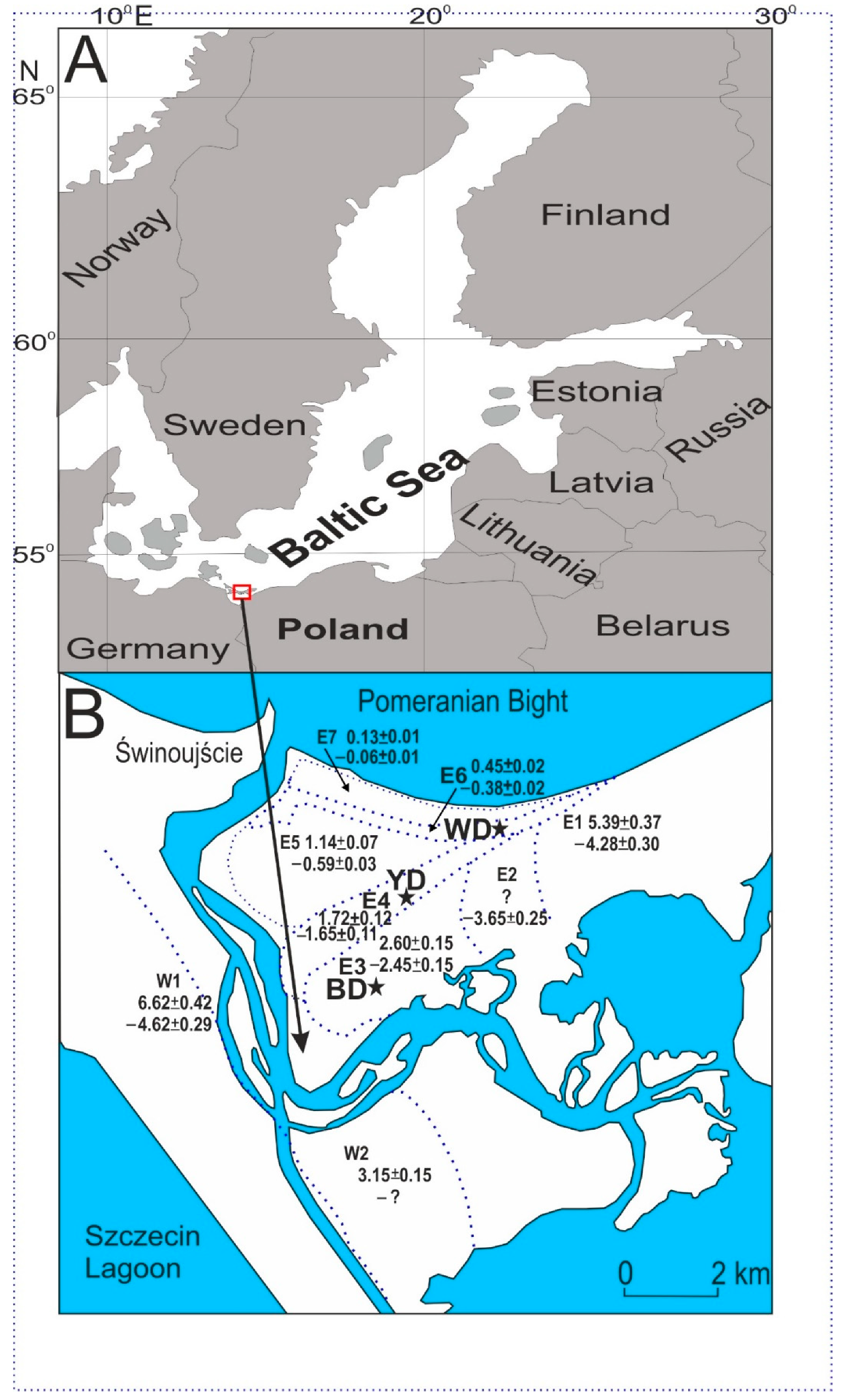
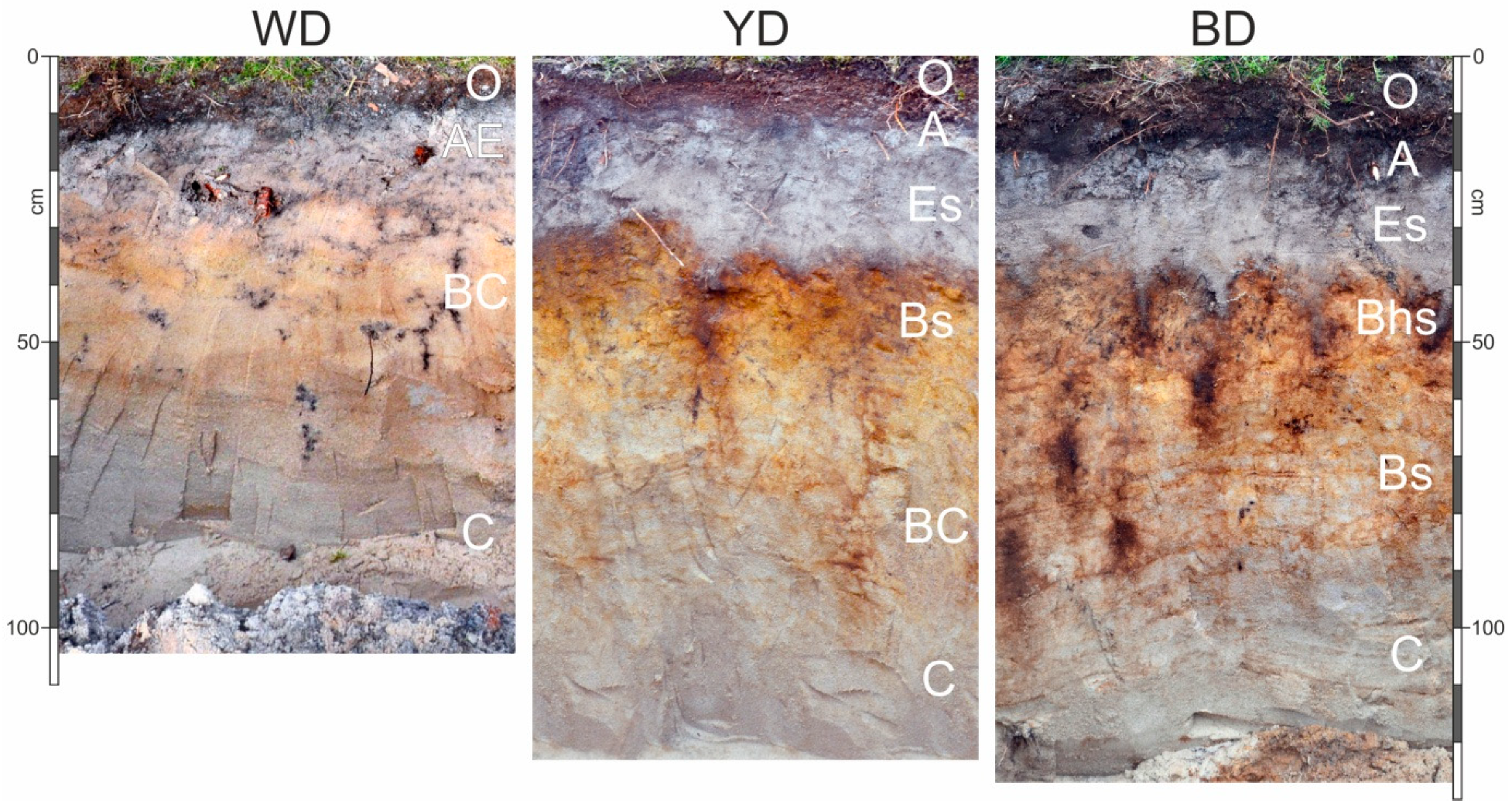



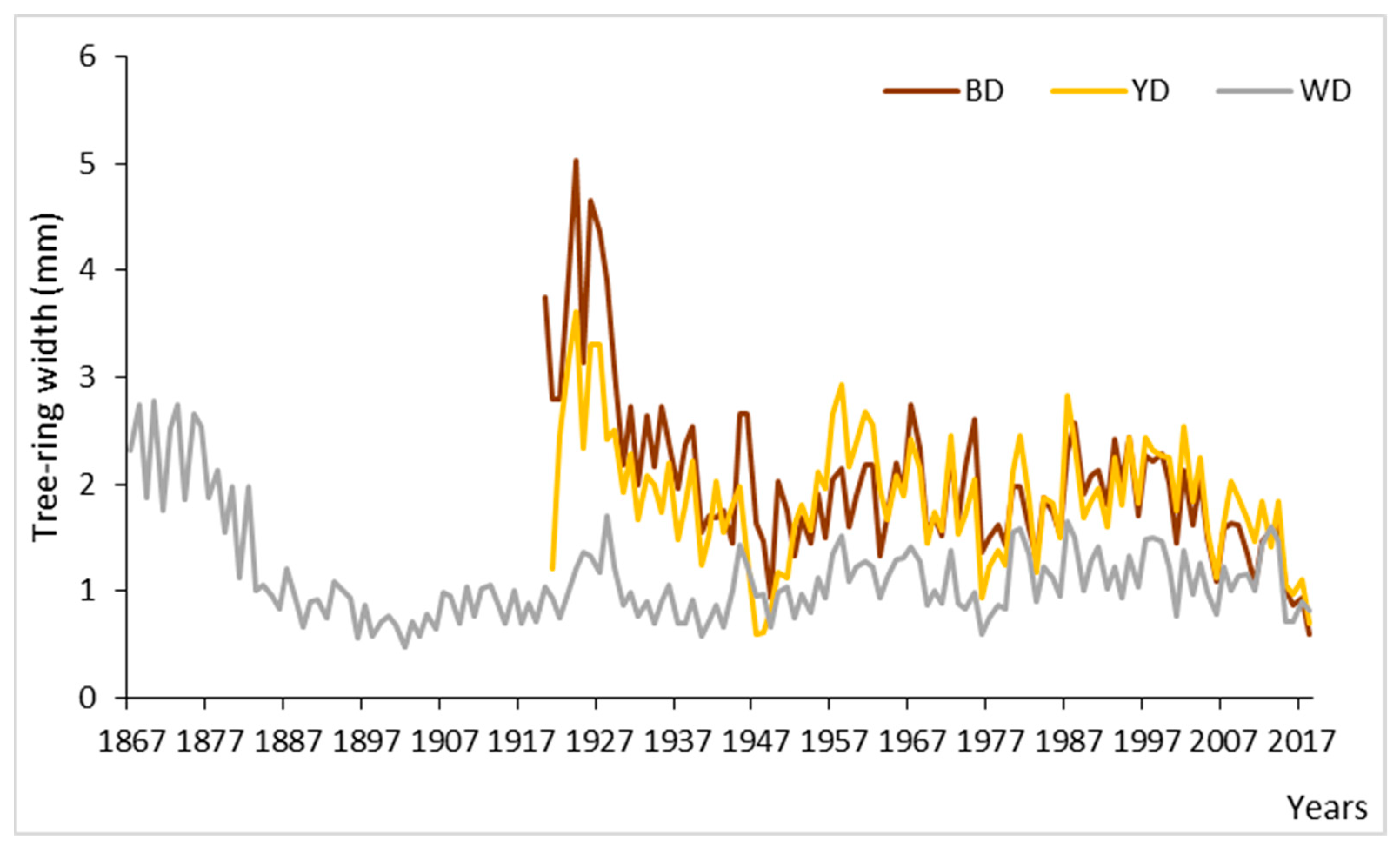
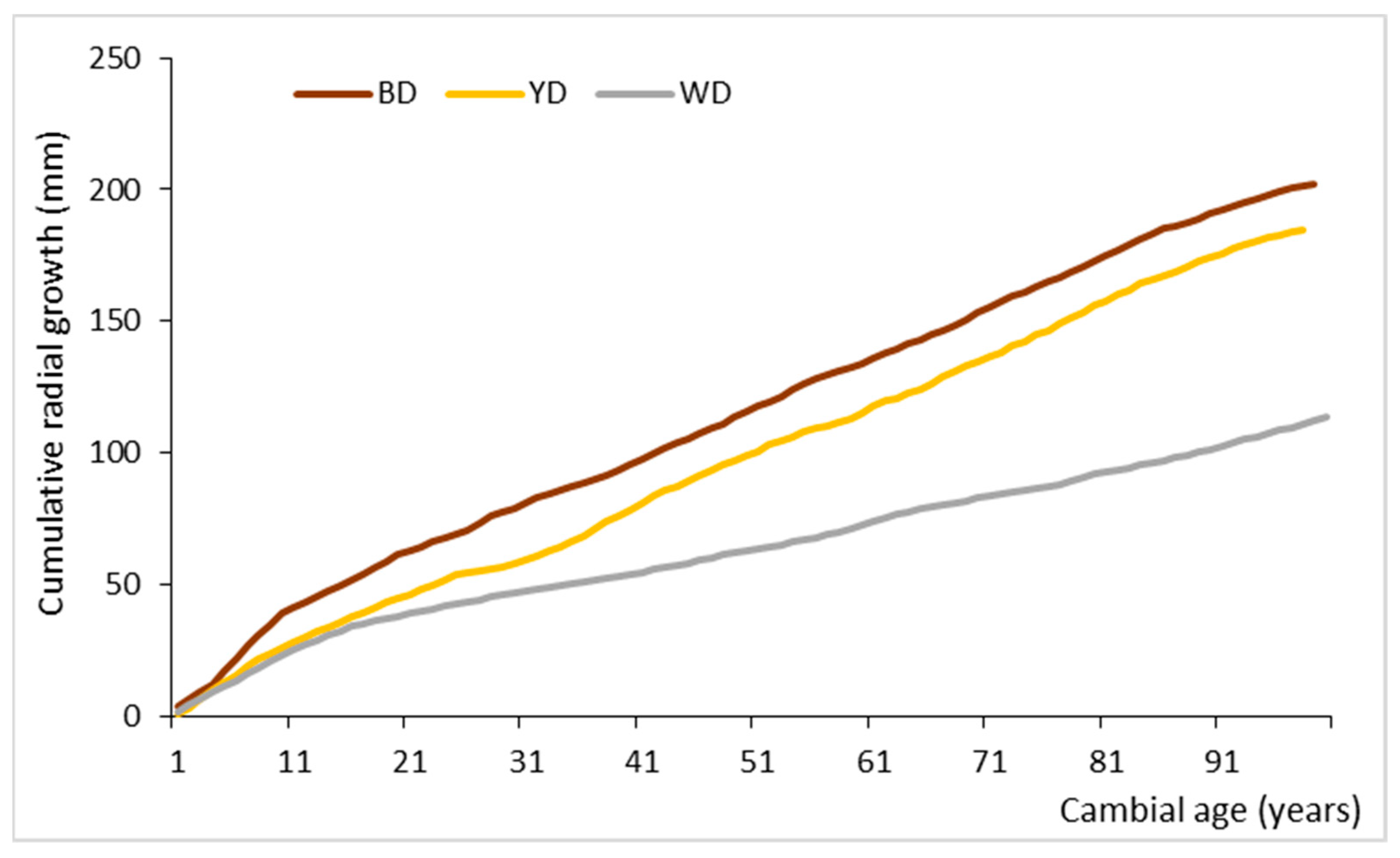
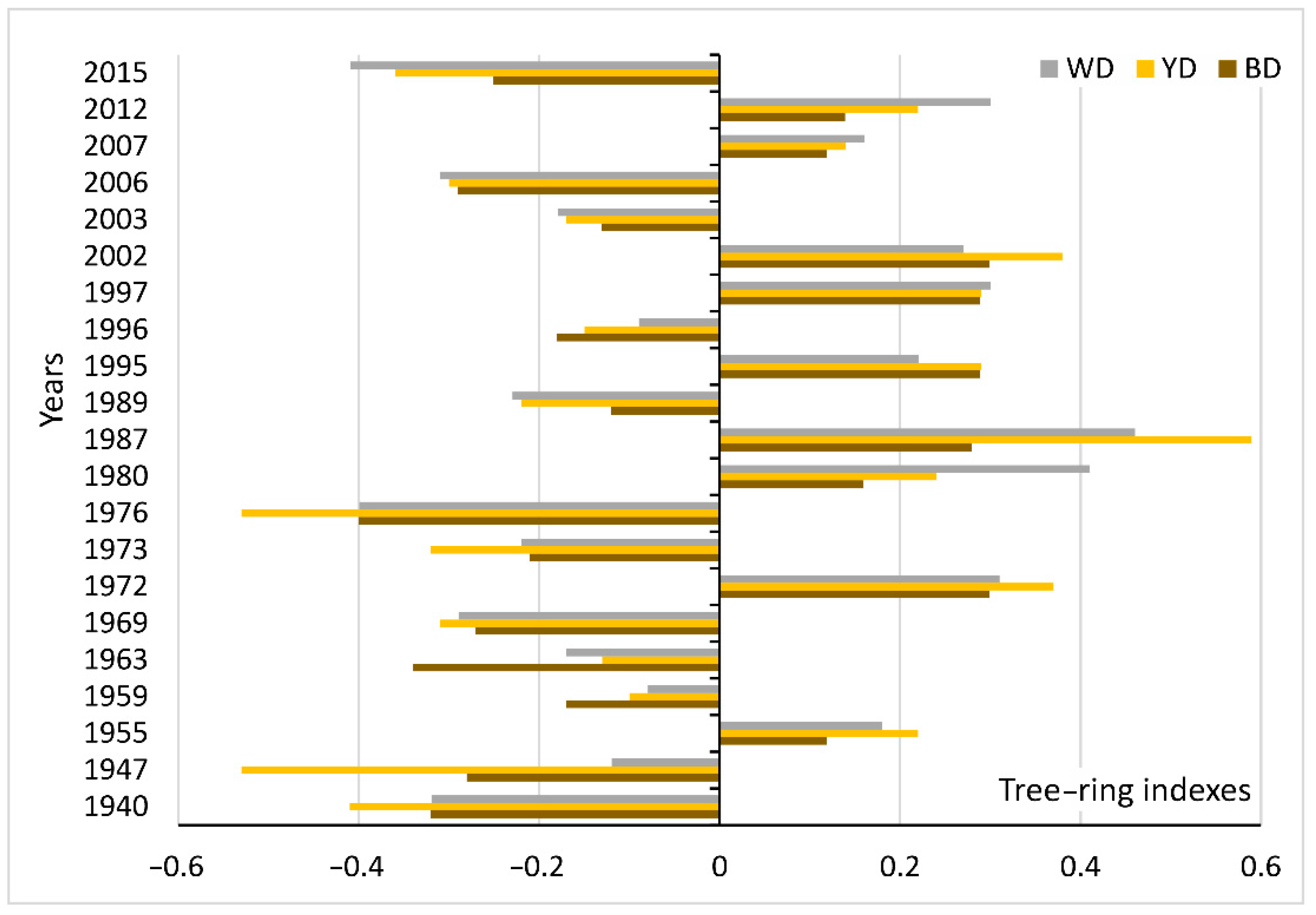


| Samples | Mz | σI | SkI | KG |
|---|---|---|---|---|
| BD/Es | 2.006 | 0.490 | −0.193 | 1.051 |
| BD/Bhs | 2.001 | 0.440 | −0.260 | 1.013 |
| BD/Bs | 2.009 | 0.459 | −0.246 | 1.013 |
| BD/C | 2.010 | 0.413 | −0.307 | 0.973 |
| YD/A | 2.027 | 0.495 | 0.010 | 1.067 |
| YD/Es | 2.044 | 0.470 | −0.044 | 1.044 |
| YD/Bs | 2.042 | 0.422 | 0.000 | 0.998 |
| YD/BC | 2.009 | 0.413 | −0.013 | 0.979 |
| YD/C | 2.124 | 0.413 | 0.101 | 1.150 |
| WD/AE | 2.016 | 0.460 | −0.280 | 1.091 |
| WD/BC | 2.009 | 0.418 | −0.321 | 0.978 |
| WD/C1 | 2.022 | 0.410 | −0.292 | 1.013 |
| WD/C2 | 2.022 | 0.407 | −0.295 | 0.988 |
| Dune Type | Depth (cm) | Symbol | pH H2O | pH KCl | C Org. (%) | N Tot. (%) | C:N | Fe Tot. (mg·kg−1) |
|---|---|---|---|---|---|---|---|---|
| BD | 0–15 | O | 3.2 | 2.5 | 30.9 | 1.0 | 29.4 | 3078 |
| 15–25 | A | 3.4 | 2.6 | 8.2 | 0.3 | 30.3 | 1110 | |
| 25–45 | Es | 3.6 | 3.4 | 0.4 | 0.3 | 1.3 | 782 | |
| 45–60 | Bhs | 4.3 | 3.9 | 0.6 | 0.5 | 1.3 | 1825 | |
| 60–90 | Bs | - | - | - | - | - | - | |
| 90–120 | C | - | - | - | - | - | - | |
| YD | 0–10 | O | 3.5 | 2.5 | 40.8 | 1.6 | 25.8 | 3351 |
| 10–30 | A | 3.4 | 2.9 | 1.7 | 0.1 | 19.1 | 1159 | |
| 30–40 | Es | 4.1 | 3.4 | 0.4 | 0.1 | 3.7 | 839 | |
| 40–50 | Bs | 3.8 | 3.4 | 0.8 | 0.1 | 6.6 | 2222 | |
| 50–80 | BC | - | - | - | - | - | - | |
| 80–120 | C | - | - | - | - | - | - | |
| WD | 0–12 | O | 3.4 | 2.5 | 44.8 | 1.4 | 31.6 | 1317 |
| 12–25 | AE | 3.9 | 2.3 | 0.5 | 0.2 | 2.3 | 1234 | |
| 25–60 | BC | - | - | - | - | - | - | |
| 60–100 | C | - | - | - | - | - | - |
| Lab. Code | No. of Years | Time Span | No. of Samples | Mean TRW (Min–Max) (mm) | Measured Chronology | Residual Chronology | EPS | ||||
|---|---|---|---|---|---|---|---|---|---|---|---|
| SD | 1AC | MS | SD | 1AC | MS | ||||||
| BD | 93 | 1926–2018 | 21 | 1.93 (1.43–2.42) | 0.867 | 0.633 | 0.279 | 0.210 | −0.088 | 0.259 | 0.95 |
| YD | 92 | 1927–2018 | 22 | 1.83 (1.25–2.42) | 0.806 | 0.609 | 0.300 | 0.237 | −0.082 | 0.296 | 0.93 |
| WD | 139 | 1880–2018 | 18 | 1.03 (0.80–1.80) | 0.538 | 0.629 | 0.297 | 0.216 | 0.017 | 0.265 | 0.88 |
Publisher’s Note: MDPI stays neutral with regard to jurisdictional claims in published maps and institutional affiliations. |
© 2022 by the authors. Licensee MDPI, Basel, Switzerland. This article is an open access article distributed under the terms and conditions of the Creative Commons Attribution (CC BY) license (https://creativecommons.org/licenses/by/4.0/).
Share and Cite
Cedro, A.; Cedro, B.; Podlasiński, M. Differences in Growth–Climate Relationships among Scots Pines Growing on Various Dune Generations on the Southern Baltic Coast. Forests 2022, 13, 470. https://doi.org/10.3390/f13030470
Cedro A, Cedro B, Podlasiński M. Differences in Growth–Climate Relationships among Scots Pines Growing on Various Dune Generations on the Southern Baltic Coast. Forests. 2022; 13(3):470. https://doi.org/10.3390/f13030470
Chicago/Turabian StyleCedro, Anna, Bernard Cedro, and Marek Podlasiński. 2022. "Differences in Growth–Climate Relationships among Scots Pines Growing on Various Dune Generations on the Southern Baltic Coast" Forests 13, no. 3: 470. https://doi.org/10.3390/f13030470
APA StyleCedro, A., Cedro, B., & Podlasiński, M. (2022). Differences in Growth–Climate Relationships among Scots Pines Growing on Various Dune Generations on the Southern Baltic Coast. Forests, 13(3), 470. https://doi.org/10.3390/f13030470







